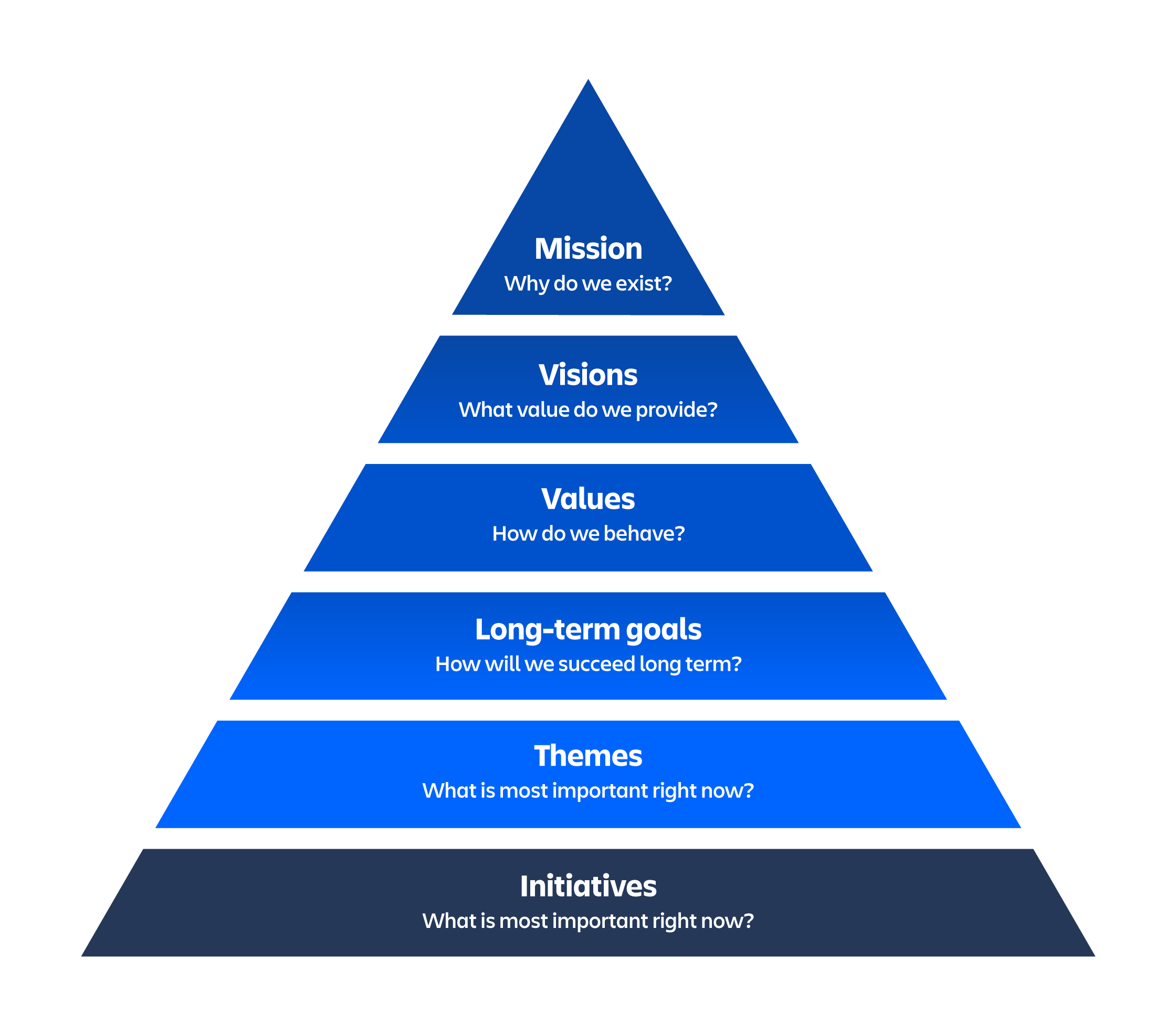The world is changing fast, and customer expectations are changing just as quickly. The pace of change has prompted enterprises to heavily invest in digital and agile transformations, where the benefits of agile teams are scaled and multiplied across the enterprise. But few organizations achieve the desired results. To realize the full value of an agile or digital transformation, business and technology teams must get aligned and stay aligned. A connected enterprise with full alignment is key to competing in the modern economy.
The challenge of connecting agile teams into an agile enterprise is that a gap emerges between the teams doing the work and the teams allocating the funding. To close this gap, leaders need the ability to:
- Gain visibility - Make the work visible in backlogs (for plans) and demos (for emerging solutions)
- Figure out what works - Review the incremental output to assess progress towards outcomes
- Optimize investments - Pivot or persevere by reallocating funds to maximize throughput of value
As businesses seek alignment and to stay aligned, they often find traditional methods of portfolio management are ineffective. Instead, many adopt Lean Portfolio Management practices to drive alignment across the entire organization.
What is Lean Portfolio Management?
Lean Portfolio Management (LPM) describes how senior leadership applies lean principles to connect strategy to execution. Portfolio management teams learn about an enterprise’s strategy and allocate a budget towards the execution of that strategy.
Like any portfolio, an LPM portfolio of investments is creatively determined and actively managed across the investment life cycle. The primary emphasis of LPM is to align agile development with business strategy, with a focus on driving the delivery of value to customers through the creation of products and solutions. Combining LPM with agile development practices offers a path to improving business agility.

The objectives of Lean Portfolio Management are to:
- Maximize the throughput of value - Actively manage the backlog of investments to find the highest-value opportunities, and actively manage WIP across groups of teams(team-of-teams) to speed the delivery of value into the marketplace
- Prevent bottlenecks - Use the portfolio budget to balance the funding for capacity with the demand for the highest-value opportunities
- Demonstrate good servant leadership - Remove obstacles to keep delivery cycle times low
LPM differs from traditional project portfolio management in a number of ways, including:
- Bringing the work to the people not the people to the work
- Focusing on defining the desired outcomes, instead of the desired quantity of outputs
- Developing a definition of “value” and focusing more on value delivery than managing costs
- Revisiting past decisions and plans every quarter based on new feedback
- Managing budgets and finances quarterly instead of annually
While traditional Project Portfolio Management (PPM) focuses on creating a set of tightly structured project plans and building short-lived teams to execute those plans, LPM focuses on:
- Bringing loosely structured value opportunities to long-standing team-of-teams
- Asking teams to define the needed work
- Monitoring emerging solutions to iterate toward market fit
How portfolio management has evolved
Portfolio management leadership teams connect an organization’s strategy to its execution. But what does the portfolio consist of?
We’ve seen the term portfolio used in different ways:
- Business Portfolio - A diversified set of businesses that pursue success on different timeline horizons
- Funding is allocated to business leaders to build plans for their own development teams
- Product (Line) Portfolio - An R&D collection of customer-facing products
- Funding is allocated to product leaders to build plans to execute their vision
- Project Portfolio - A set of large initiatives, scoped and funded to yield changes in the product lines
- Funding is allocated to execute specific plans expected to yield specific outputs
- IT Project Portfolio - A set of large initiatives, scoped and funded to yield changes in the internal systems across the enterprise
- Funding is allocated to execute specific plans that are expected to yield specific improvements through IT
- Lean Portfolio - A set of strategic business targets captured in initiatives
- Funding is allocated to team-of-teams that must use their resources to accomplish the initiatives
What do they have in common? Each has the ability to allocate funding, translate enterprise strategy into a local context, and govern execution and spending.
Over the last decade, some enterprise leaders have improved responsiveness and speed-to-market by shifting to portfolios of strategic initiatives implemented by team-of-teams. These successes formed the foundation of Lean Portfolio Management.
Why Lean Portfolio Management?
Organizations that focus on defining projects that span more than a year often get stuck in situations where teams are incentivized to meet out-of-date project goals, instead of delivering value early or seeking early feedback on market-fit. Lean portfolio management methods help organizations:
- Shift the operations focus to delivering incremental value at shorter cadences for larger initiatives.
- Leverage the cadences to achieve shorter feedback loops. Feedback collected via internal teams, external focus groups, customers, or end users helps measure progress towards the organization’s target outcomes.
- Ruthlessly apply the feedback to reinvest in ideas that produce good outcomes and downshift on ideas that do not.
Lean Portfolio Management, informed by lean principles and built through a better understanding of customer value (and how to deliver it quickly), remedies some common pain points in large organizations.
Pain point #1: Long cycle times on large initiatives.
- When organizations build autonomous, cross-functional teams, they remove handoffs and dependencies that add friction (and delays) to the delivery of value.
- When organizations improve their definition of customer value, communication improves and clears the path for the best ideas.
- When organizations emphasize a planning and execution model that yields continuous value flow, they strive to put value in customers' hands, instead of marking tasks as complete.
Pain point #2: Work gets done, but the key needles don’t move.
- When organizations define goals in terms of targeted business outcomes, they are more likely to “move the needle” on their key performance indicators (KPIs).
- When organizations evaluate those outputs in short feedback loops, they can quickly recalibrate short-term plans, based on what they see right now.
- When organizations set objective-based goals, captured as desired business outcomes, the incremental outputs can be evaluated against the desired business outcomes.
Pain point #3: Budgets are difficult to change based on new information.
- When organizations face a high amount of uncertainty in the marketplace, they can apply a lean start-up mindset to “think in bets.” In doing so, they can explore the solution space in a cost-effective way that funds small experiments, not large initiatives with substantial uncertainty.
- When organizations fund team-of-teams through agile budgeting, then empower them to build plans that align to strategic goals, the new distributed accountability model speeds up the overall delivery of value.
Key elements of Lean Portfolio Management
The lean portfolio leadership team sets the “north star” goal for the mission, funds the team-of-teams based on the enterprise’s strategic needs, then monitors the emergent plans and results to make sure they align to the strategic intent.
The leadership team makes decisions at a set cadence, and both the operations (activities they perform) and the governance (reviews that they hold) follow that cadence to synchronize and align the planning and feedback loops.
LPM operations
To continuously connect strategy to execution, the leadership team continuously assesses these targets:
Set mission
- Set (and recalibrate every quarter) the outcome-based objectives and strategic themes
Find opportunities
- Turn new ideas into investment candidates tied to the strategic mission
Target value delivery
- Build roadmaps based on market needs and the anticipated size of the effort, which should be collected during agile estimation and planning
Optimize for value
- Set clear priorities on the initiatives to (1) drive detailed planning for the next quarter, and (2) balance the roadmap against known capacity constraints
Check market fit
- “Go see” the incremental value delivered in the team demos and validate the value hypotheses
LPM governance
To achieve enterprise agility, the leadership team facilitates periodic reviews:
Strategy alignment review
- Once a quarter, confirm that the work aligns with the strategic intent
Portfolio budget review
- Once a quarter, confirm that the budget allocations funding the team-of-teams (and empowering their decentralized decision-making) is best supporting the mission
Portfolio team retrospective
- Once a quarter, look to improve the way that the portfolio leadership team operates, makes decisions, achieves continuous value flow
Portfolio financial review
- Once a month, compare the spending trends on the initiatives to the targets and guardrails to close the loop on agile budgeting
Portfolio roadmap review
- Once a month, share the updated initiative roadmap with all stakeholders
Investment opportunity review
- Once a week, approve funding for new investment opportunities based on their business case (or recalibrate past funding decisions based on new feedback)
How to implement Lean Portfolio Management
Adopting lean practices into existing portfolio leadership teams is a significant change and requires strong organizational change management practices. It often feels like renovating a house while you’re living in it—with similar levels of stress and satisfaction. To continue with this analogy, here are some tips for a lean home renovation:
- Find the owners - Portfolio leadership teams are high-performing, cross-functional teams of servant leaders. Unleashing the power of a leadership team is no less important than empowering a development team. The first step is to find and form the group that will connect strategy to execution for a specific part of the organization. That is the portfolio leadership team.
- Find the money - LPM shifts the strategy and investment model from funding projects to funding team-of-teams. This drives the need for a deeper understanding (and visibility) into the connection between the strategic aims of the business and the way that team-of-teams build plans.
Here are some questions that will need to be answered:- Who is providing the funding to the portfolio? What are they expecting from it?
- Who provides the funding to “keep the lights” on (or run the business vs. change the business)?
- How many different, independently funded strategies will be driving the portfolio?
- Renovate - Even within the same organization, no two leadership teams will want to take exactly the same approach to agile portfolio operations. Discover the needs and expectations of the portfolio leadership team, including where they want to initially land between their current state and a (leaner) future state. Build an operating structure that embodies the key pieces of LPM, with a customized feel.
- Move back in - Recalibrate the active, funded work into leaner constructs that better support the flow of value, and consider using this opportunity to revisit the rationale for the work (pivot or persevere?). Lean encourages an organization to “maximize the work not done”. Can any active work be stopped or scaled back?
- Redecorate - LPM brings in new decision-making techniques, like the emphasis on visualizing strategic alignment of the work and “guardrail-based” governance. This drives the need to “re-instrument” existing work management systems to add new disciplines and additional clarity.
- Throw a party - Lean portfolio leadership teams make decisions and improvements at a set cadence. Surface positive feedback from retrospectives and make sure to celebrate the improved flow of value through the organization!
Lean Portfolio Management brings time-tested lean principles to the teams and leaders that are best positioned to drive organizational change. Overall, the lean approach drives reliable value delivery, reduces time to customer value, and ensures that teams can pivot as the marketplace changes or customer demands shift. Lean Portfolio Management offers a path to maximizing these advantages and building a more connected enterprise.
Interested in learning more about Lean Portfolio Management? Dive deeper into the fundamentals of LPM and see how Atlassian's Jira Align supports it.
